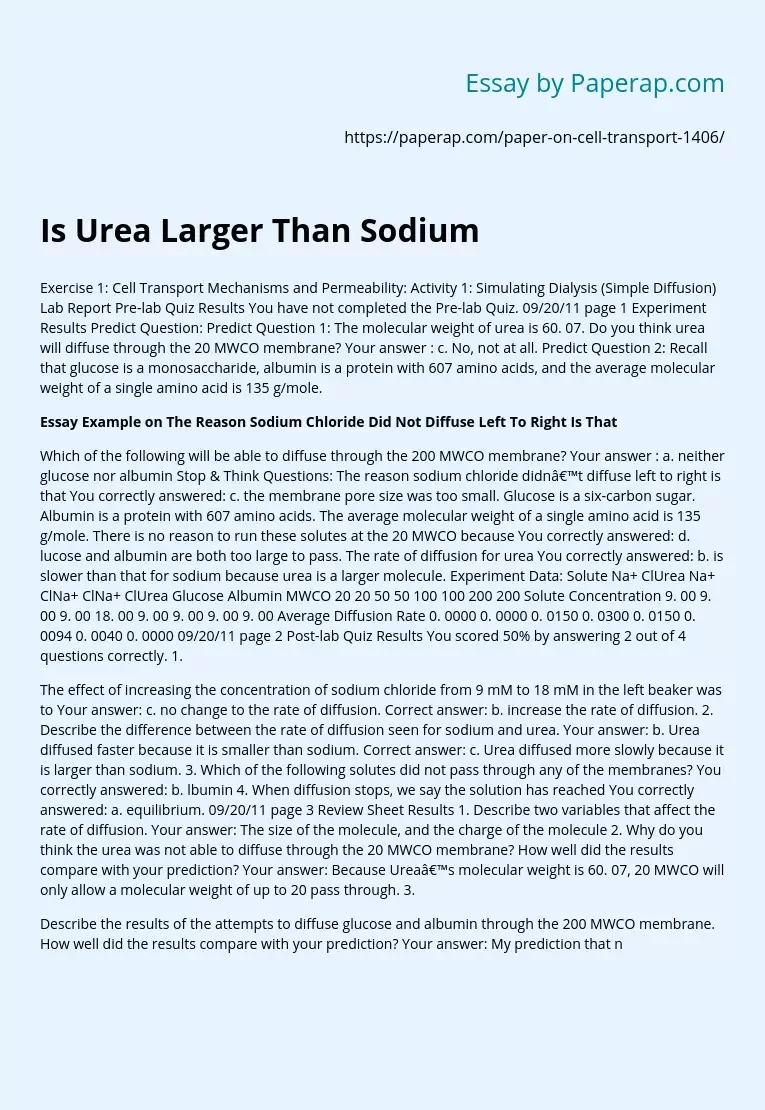Is Urea Larger Than Sodium
Exercise 1: Cell Transport Mechanisms and Permeability: Activity 1: Simulating Dialysis (Simple Diffusion) Lab Report Pre-lab Quiz Results You have not completed the Pre-lab Quiz. 09/20/11 page 1 Experiment Results Predict Question: Predict Question 1: The molecular weight of urea is 60. 07. Do you think urea will diffuse through the 20 MWCO membrane? Your answer : c. No, not at all. Predict Question 2: Recall that glucose is a monosaccharide, albumin is a protein with 607 amino acids, and the average molecular weight of a single amino acid is 135 g/mole.
Essay Example on The Reason Sodium Chloride Did Not Diffuse Left To Right Is That
Which of the following will be able to diffuse through the 200 MWCO membrane? Your answer : a. neither glucose nor albumin Stop & Think Questions: The reason sodium chloride didn’t diffuse left to right is that You correctly answered: c. the membrane pore size was too small. Glucose is a six-carbon sugar. Albumin is a protein with 607 amino acids. The average molecular weight of a single amino acid is 135 g/mole. There is no reason to run these solutes at the 20 MWCO because You correctly answered: d. lucose and albumin are both too large to pass. The rate of diffusion for urea You correctly answered: b. is slower than that for sodium because urea is a larger molecule. Experiment Data: Solute Na+ ClUrea Na+ ClNa+ ClNa+ ClUrea Glucose Albumin MWCO 20 20 50 50 100 100 200 200 Solute Concentration 9. 00 9. 00 9. 00 18. 00 9. 00 9. 00 9. 00 9. 00 Average Diffusion Rate 0. 0000 0. 0000 0. 0150 0. 0300 0. 0150 0. 0094 0. 0040 0. 0000 09/20/11 page 2 Post-lab Quiz Results You scored 50% by answering 2 out of 4 questions correctly. 1.
The effect of increasing the concentration of sodium chloride from 9 mM to 18 mM in the left beaker was to Your answer: c.
no change to the rate of diffusion. Correct answer: b. increase the rate of diffusion. 2. Describe the difference between the rate of diffusion seen for sodium and urea. Your answer: b. Urea diffused faster because it is smaller than sodium. Correct answer: c. Urea diffused more slowly because it is larger than sodium. 3. Which of the following solutes did not pass through any of the membranes? You correctly answered: b. lbumin 4. When diffusion stops, we say the solution has reached You correctly answered: a. equilibrium. 09/20/11 page 3 Review Sheet Results 1. Describe two variables that affect the rate of diffusion. Your answer: The size of the molecule, and the charge of the molecule 2. Why do you think the urea was not able to diffuse through the 20 MWCO membrane? How well did the results compare with your prediction? Your answer: Because Urea’s molecular weight is 60. 07, 20 MWCO will only allow a molecular weight of up to 20 pass through. 3.
Describe the results of the attempts to diffuse glucose and albumin through the 200 MWCO membrane. How well did the results compare with your prediction? Your answer: My prediction that neither glucose nor albumin would pass through the 200 MWCO membrane was wrong, true albumin did not pass through but gucose did because it is a smaller molecule. 4. Put the following in order from smallest to largest molecular weight: glucose, sodium chloride, albumin, and urea. Your answer: Sodium, Chloride, Urea, Glucose, Albumin 09/20/11 page 4
Is Urea Larger Than Sodium. (2019, Nov 27). Retrieved from https://paperap.com/paper-on-cell-transport-1406/

